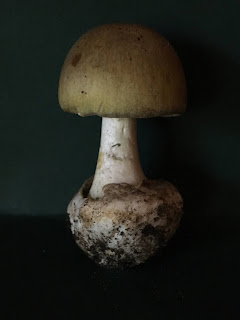Beguiling Beauty: the Death Cap

Autumn is when mushroom enthusiasts in the Pacific Northwest are bent low to the ground sleuthing for fruiting bodies of fungi that are popping up everywhere. Fortunately for foragers and harvesters there are few (three) mushrooms that are deadly poisonous. Let's get acquainted with the enticing but toxic Death Cap (Amanita phalloides). The Death Cap is found low to the ground and has elegant proportions with a bell shaped cap that is pale olive green with a luster that often looks metallic. The gills are white as are the spores (observe the white spore print that I have included); spore color is an important feature in determining mushroom types. Notice the sac-like volva at the base of this mushroom: not all mushrooms have this feature but all Death Caps have volvas! The toxin in this Amanita is a potent cyclopeptide called amanitin. Amanitin disrupts the function of protein enzymes that leads to liver and kidney fa...
